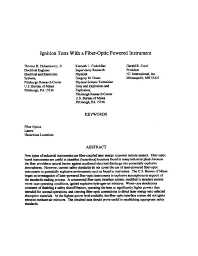Mining Publication: Ignition Tests With a Fiber-Optic Powered Instrument
Original creation date: September 1996
New types of industrial instruments use fiber-coupled laser energy to power remote sensors. Fiber-optic based instruments are useful in classified (hazardous) locations found in many industrial plants because the fiber provides a natural barrier against accidental electrical discharge into potentially explosive atmospheres. However, current safety standards do not cover the use of laser-powered fiber-optic instruments in potentially explosive environments such as found in coal mines. The U.S. Bureau of Mines began an investigation of laser-powered fiber-optic instruments in explosive atmospheres in support of the standard-making process. A commercial fiber-optic interface system, modified to simulate several worst-case operating conditions, ignited explosive hydrogen-air mixtures. Worst-case simulations consisted of disabling a safety shutoff feature, operating the laser at significantly higher powers than intended for normal operations, and cleaving fiber-optic connections to direct laser energy onto selected absorptive materials. At the highest power level available, the fiber-optic interface system did not ignite selected methane-air mixtures. The obtained data should prove useful in establishing appropriate safety standards.
Authors: TH Dubaniewicz, KL Cashdollar, GR Cucci
Conference Paper - September 1996
NIOSHTIC2 Number: 20023919
Proc 41st Annual ISA Analysis Div. Symposium, 1996, Framingham, Massachusetts, 29, 1996; :175-184
See Also
- Battery Safety Enhancements for Underground Coal Mines
- Continuous Wave Laser Ignition Thresholds of Coal Dust Clouds
- Further Study of the Intrinsic Safety of Internally Shorted Lithium and Lithium-ion Cells Within Methane-air
- Ignition of Hydraulic Fluid Sprays by Open Flames and Hot Surfaces
- Ignition of Methane-Air Mixtures by Laser Heated Small Particles
- Investigation of Ampacity Derating Factors for Shuttle Cars Using Fiber Optics Technology
- Lasers
- Methane-Air Mixtures Ignited by CW Laser-Heated Targets on Optical Fiber Tips: Comparison of Targets, Optical Fibers, and Ignition Delays
- Technical Solutions for Enhancements to Mine Safety Using Barricade II Fire Blocking Gel
- Threshold Powers and Delays for Igniting Propane and Butane-Air Mixtures by CW Laser-heated Small Particles
- Page last reviewed: 7/20/2015
- Page last updated: 7/20/2015
- Content source: National Institute for Occupational Safety and Health, Mining Program


 ShareCompartir
ShareCompartir
